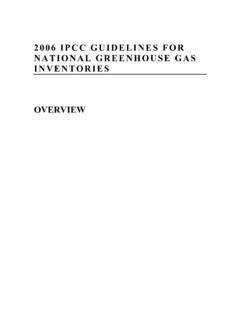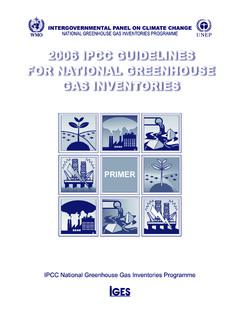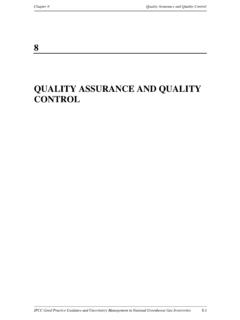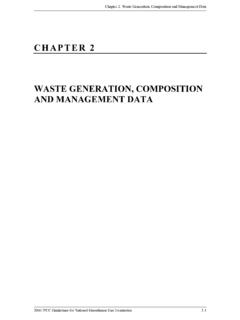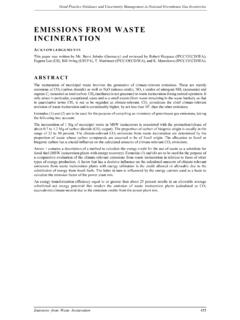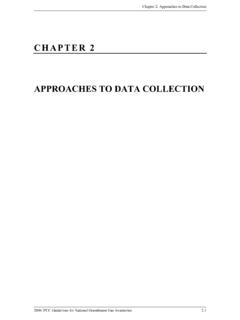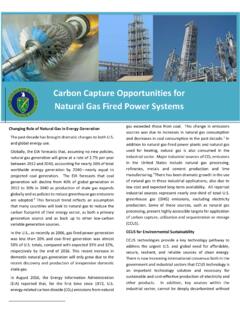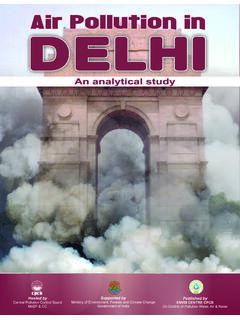Transcription of CHAPTER 1 INTRODUCTION - IGES
1 CHAPTER 1: INTRODUCTION 2006 IPCC Guidelines for National Greenhouse Gas Inventories CHAPTER 1 INTRODUCTION Volume 2: Energy 2006 IPCC Guidelines for National Greenhouse Gas Inventories Authors Amit Garg (India), Kainou Kazunari (Japan), and Tinus Pulles (Netherlands), CHAPTER 1: INTRODUCTION 2006 IPCC Guidelines for National Greenhouse Gas Inventories Contents 1 INTRODUCTION INTRODUCTION .. Source Methodological Emissions from fossil fuel combustion .. Tiers .. Selecting tiers: a general decision tree .. Relation to other inventory approaches .. Fugitive emissions .. CO2 capture and storage .. Data collection issues .. Activity data .. Fuel definitions .. Conversion of energy units .. Activity data Time series consistency .. Emission factors .. CO2 emission factors .. Other greenhouse gases.
2 Indirect greenhouse gases .. Uncertainty in inventory estimates .. General .. Activity data uncertainties .. Emission factor uncertainties .. QA/QC and completeness .. Reference Approach .. Potential double counting between Non-energy use of fuels .. Waste as a fuel .. Mobile versus stationary combustion .. National New sources .. References .. Volume 2: Energy 2006 IPCC Guidelines for National Greenhouse Gas Inventories Figures Figure Activity and source structure in the energy Figure Generalised decision tree for estimating emissions from fuel Figure Some typical examples of probability distribution functions (PDFs) for the effective CO2 emission factors for the combustion of Tables Table Definitions of fuel types used in the 2006 IPCC Table Default net calorific values (NCVs) and lower and upper limits of the 95 percent confidence intervals.
3 Table Default values of carbon content .. Table Default CO2 emission factors for combustion .. Box Box Conversion between gross and net calorific values .. CHAPTER 1: INTRODUCTION 2006 IPCC Guidelines for National Greenhouse Gas Inventories 1 INTRODUCTION INTRODUCTION Energy systems are for most economies largely driven by the combustion of fossil fuels. During combustion the carbon and hydrogen of the fossil fuels are converted mainly into carbon dioxide (CO2) and water (H2O), releasing the chemical energy in the fuel as heat. This heat is generally either used directly or used (with some conversion losses) to produce mechanical energy, often to generate electricity or for transportation. The energy sector is usually the most important sector in greenhouse gas emission inventories, and typically contributes over 90 percent of the CO2 emissions and 75 percent of the total greenhouse gas emissions in developed countries.
4 CO2 accounts typically for 95 percent of energy sector emissions with methane and nitrous oxide responsible for the balance. Stationary combustion is usually responsible for about 70 percent of the greenhouse gas emissions from the energy sector. About half of these emissions are associated with combustion in energy industries mainly power plants and refineries. Mobile combustion (road and other traffic) causes about one quarter of the emissions in the energy sector. SOURCE CATEGORIES The energy sector mainly comprises: exploration and exploitation of primary energy sources, conversion of primary energy sources into more useable energy forms in refineries and power plants transmission and distribution of fuels use of fuels in stationary and mobile applications. Emissions arise from these activities by combustion and as fugitive emissions, or escape without combustion .
5 For inventory purposes, fuel combustion may be defined as the intentional oxidation of materials within an apparatus that is designed to provide heat or mechanical work to a process, or for use away from the apparatus. This definition aims to separate the combustion of fuels for distinct and productive energy use from the heat released from the use of hydrocarbons in chemical reactions in industrial processes, or from the use of hydrocarbons as industrial products. It is good practice to apply this definition as fully as possible but there are cases where demarcation with the industrial processes and product use (IPPU) sector is needed. The following principle has been adopted for this: combustion emissions from fuels obtained directly or indirectly from the feedstock for an IPPU process will normally be allocated to the part of the source category in which the process occurs.
6 These source categories are normally 2B and 2C. However, if the derived fuels are transferred for combustion in another source category, the emissions should be reported in the appropriate part of Energy Sector source categories (normally 1A1 or 1A2). Please refer to Box and section in CHAPTER 1 of the IPPU Volume for examples and further details. When the total emissions from the gases are calculated, the quantity transferred to the energy sector should be noted as an information item under IPPU source category and reported in the relevant energy sector source category to avoid double counting. Typically, only a few percent of the emissions in the energy sector arise as fugitive emissions from extraction, transformation and transportation of primary energy carriers. Examples are leakage of natural gas and the emissions of methane during coal mining and flaring during oil/gas extraction and refining1.
7 In some cases where countries produce or transport significant quantities of fossil fuels, fugitive emissions can make a much larger contribution to the national total. combustion and fugitive emissions from production, processing and handling of oil and gas should be allocated according to the national territory of the facilities including offshore areas (see CHAPTER 8 - section in Vol. 1). These offshore areas may be an economic zone agreed upon with other countries. 1 Note that the combustion emissions due to transport of energy carriers by ship, rail and road are included in the mobile combustion processes. Volume 2: Energy 2006 IPCC Guidelines for National Greenhouse Gas Inventories Figure shows the structure of activities and source categories within the energy sector.
8 This structure is based on the coding and naming as defined in the 1996 IPCC Guidelines and the Common Reporting Format (CRF) used by the UNFCCC. The technical chapters of this Volume follow this source category structure. METHODOLOGICAL APPROACHES Emissions from fossil fuel combustion There are three Tiers presented in the 2006 IPCC Guidelines for estimating emissions from fossil fuel combustion . In addition a Reference Approach is presented. It can be used as an independent check of the sectoral approach and to produce a first-order estimate of national greenhouse gas emissions if only very limited resources and data structures are available to the inventory compiler. The 2006 IPCC Guidelines estimate carbon emissions in terms of the species which are emitted. During the combustion process, most carbon is immediately emitted as CO2.
9 However, some carbon is released as carbon monoxide (CO), methane (CH4) or non-methane volatile organic compounds (NMVOCs). Most of the carbon emitted as these non-CO2 species eventually oxidises to CO2 in the atmosphere. This amount can be estimated from the emissions estimates of the non-CO2 gases (See Volume 1, CHAPTER 7). In the case of fuel combustion , the emissions of these non-CO2 gases contain very small amounts of carbon compared to the CO2 estimate and, at Tier 1, it is more accurate to base the CO2 estimate on the total carbon in the fuel. This is because the total carbon in the fuel depends on the fuel alone, while the emissions of the non-CO2 gases depend on many factors such as technologies, maintenance etc which, in general, are not well known. At higher tiers, the amount of carbon in these non-CO2 gases can be accounted for. Since CO2 emissions are independent of combustion technology whilst CH4 and N2O emissions are strongly dependent on the technology, this CHAPTER only provides default emission factors for CO2 that are applicable to all combustion processes, both stationary and mobile.
10 Default emission factors for the other gases are provided in subsequent chapters of this volume, since combustion technologies differ widely between source categories within the source sector combustion and hence will vary between these subsectors. TIERS TIER 1 The Tier 1 method is fuel-based, since emissions from all sources of combustion can be estimated on the basis of the quantities of fuel combusted (usually from national energy statistics) and average emission factors. Tier 1 emission factors are available for all relevant direct greenhouse gases. The quality of these emission factors differs between gases. For CO2, emission factors mainly depend upon the carbon content of the fuel. combustion conditions ( combustion efficiency, carbon retained in slag and ashes etc.) are relatively unimportant. Therefore, CO2 emissions can be estimated fairly accurately based on the total amount of fuels combusted and the averaged carbon content of the fuels.
